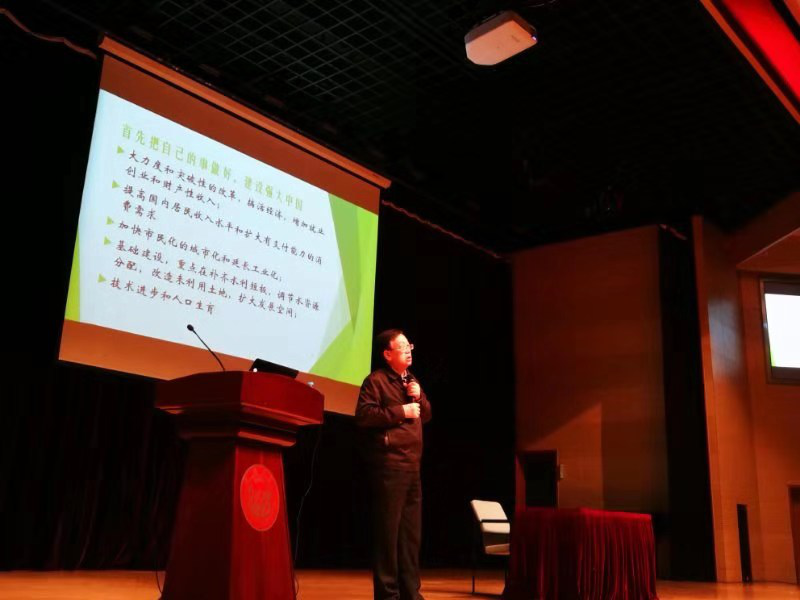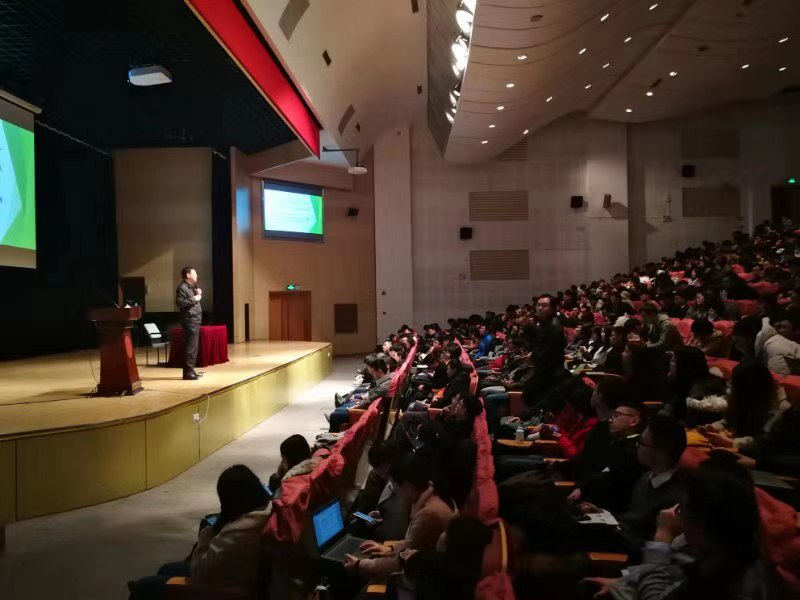News



Co-hosted by the Graduate School and the School of Political Science & International Relations (SPSIR) of Tongji University, the Tongji Advanced Lectures for Graduate Students No. 59 themed 'China-US Economic Relations and China's International Competitiveness' was held in Lecture Hall 101, Jiren Building, Jiading Campus on the evening of March 5, 2019. The speaker was Professor Zhou Tianyong, former Deputy Director of the International Strategic Research Institute at the Party School of the Central Committee of the CPC and a visiting fellow at the Institute for China & World Studies of Tongji University. Tongji Distinguished Professor Men Honghua, Dean of SPSIR and President of the Institute for China & World Studies, moderated this high-level lecture.

Around the two themes of China-US economic relations and China's international competitiveness, Prof. Zhou reviewed the profound changes in the global economic landscape and the international economic game since the end of the Cold War. In the context of economic globalization, both East Asia and China have benefited and developed under the WTO framework. East Asian countries have achieved rapid economic development by pursuing an export-oriented economic growth model, thus creating the East Asian Miracle. China’s economy took off in the 1980s and has experienced rapid economic development since Deng Xiaoping’s Southern Talks and the accession to the WTO. In the meantime, the United States has been facing many economic and social problems after the subprime crisis; the European Union has been also facing numerous economic and social problems in the post-debt era, reflected by Brexit, among others.
Prof. Zhou believed that it is necessary to look at the economic interests of China and the US before examining the China-US economic relations. The US is eager to maintain its world leadership, its competitiveness in manufacturing, trade, technology and energy, its dollar status, its discourse and dominance of rules and order, etc. While China focuses on its national rejuvenation in the 21st century, including surpassing the US in terms of total economic output, developing the manufacturing sector, driving technological advancement, internationalizing the renminbi, and modernizing its energy, transportation and urban systems. Due to its own relative decline, the US has adopted a series of competitive measures to maintain its leadership: first, marginalize the WTO, second, guide the re-shoring of its manufacturing sector; third, compete in the technology sector and launch a war on intellectual property rights; fourth, shift focus from multilateral negotiations to bilateral ones, and urge many of its partners to take sides economically in an attempt to isolate China.
In response, China has taken a number of economic measures. First and foremost, China proposed the Belt and Road Initiative (short for the Silk Road Economic Belt and the 21st Century Maritime Silk Road) in 2013 and launched a series of economic cooperation plans. Secondly, with regard to the trade war, China first resorts to reciprocal tariff measures, and then attempts to open up other import and export markets through the BRI and other methods. Thirdly, China seeks technology cooperation with and supply from other parties and works on independent innovation. For example, the US has tried to impose a chip embargo on Chinese companies such as ZTE, but China can import chips from the UK, South Korea, China Taiwan and other manufacturers. Fourthly, China controls and cracks down on capital outflows. China safeguards its foreign exchange reserves by controlling capital flight and cracking down on underground banks and overseas home purchases, etc. As a result, China’s FX reserves have increased slightly this year. Finally, China lowers tariffs and opens up markets including the service industry.

China and the US are cooperating with and balancing each other amid rivalry. The US is still the world leader, with absolute military predominance and a strong political discourse and economic power. Also, the US has the most advanced science and technology in the world, and its dollar is still the world’s most important international currency. But as China is growing as strong as the US, the US becomes very worried about the formation of a new “red empire”. Despite China’s growing strength, there is still a huge gap between China and the US: in economic development, the gap in per capita GDP is obvious although there is little difference in the total GDP; in manufacturing, China is still not as competitive as the US; in science and technology, there is an obvious gap; in transportation, energy, water and urban facilities, China is still overshadowed by the US. China has much to improve especially in the use of freshwater resources; in education, science, technology and human resources, the US still enjoys a tremendous advantage; and the renminbi is a much less international currency than the US dollar. Besides, there is a certain gap on international rulemaking, discourse power, and the future comprehensive competitiveness, etc.
Prof. Zhou then analyzed the pros and cons of the China-US trade war. The US has suffered heavy losses in agricultural and high-tech exports, hitting a new high of trade deficit. This is directly related to the loss of the Chinese market. The US stock market has begun to decline, showing the diminishing marginal effect as a result of the tax cut policy implemented by the Trump administration since last year. China is also facing a number of problems, such as greater export uncertainty, exchange rate and capital market fluctuations, increased pressure from capital outflows, and industrial transfers. It is estimated that the unemployment rate is like to increase and the economic downward pressure may increase this year. Just imagine the consequences of the trade war: the US killed 1,000 enemies and lost 800 of its own, while China killed 1,000 enemies and lost 12,000 of its own.
For China, this means the end of the past export-oriented industrialization strategy. On the one hand, developed countries such as the US are standing in the way of China’s global export, and on the other hand, other developing countries are copying the Chinese model to sell products worldwide. The developing countries combined have a vast territory, but a small market with payment capacity; therefore, in the future, China's development strategy will shift from outward-oriented to inward-oriented. China’s advantaged include: it has a huge population size and demand market; the Chinese people are hardworking, wise, dedicated, entrepreneurial and innovative; China has laid a certain foundation in education, science, technology and human resources; China has initially modernized its transportation, energy and communication systems, along with rapid urbanization. Besides, there is still potential for urbanization and industrialization, and there is a lot of room for maneuver in water and land use. Therefore, China should focus on domestic development first to build itself into a strong country.
As such, China can take the following measures. First, reinvigorate the economy, create jobs, encourage entrepreneurship and increase property income through vigorous and disruptive reforms. Second, increase domestic household income and expand consumer demand with payment capacity, and accelerate urbanization and extend industrialization. Third, in terms of infrastructure, China should make up for its shortcomings in water conservancy, reallocate water resources and transform unused land to expand space for development. Fourth, in terms of human resources, China should further encourage childbearing, since maintaining a positive population growth is the key to future economic development and technological progress.

More than 600 undergraduates from Tongji University listened to this lively lecture and asked questions actively. The lecture lasted for two and a half hours, which was nearly 1 hour longer than the scheduled.